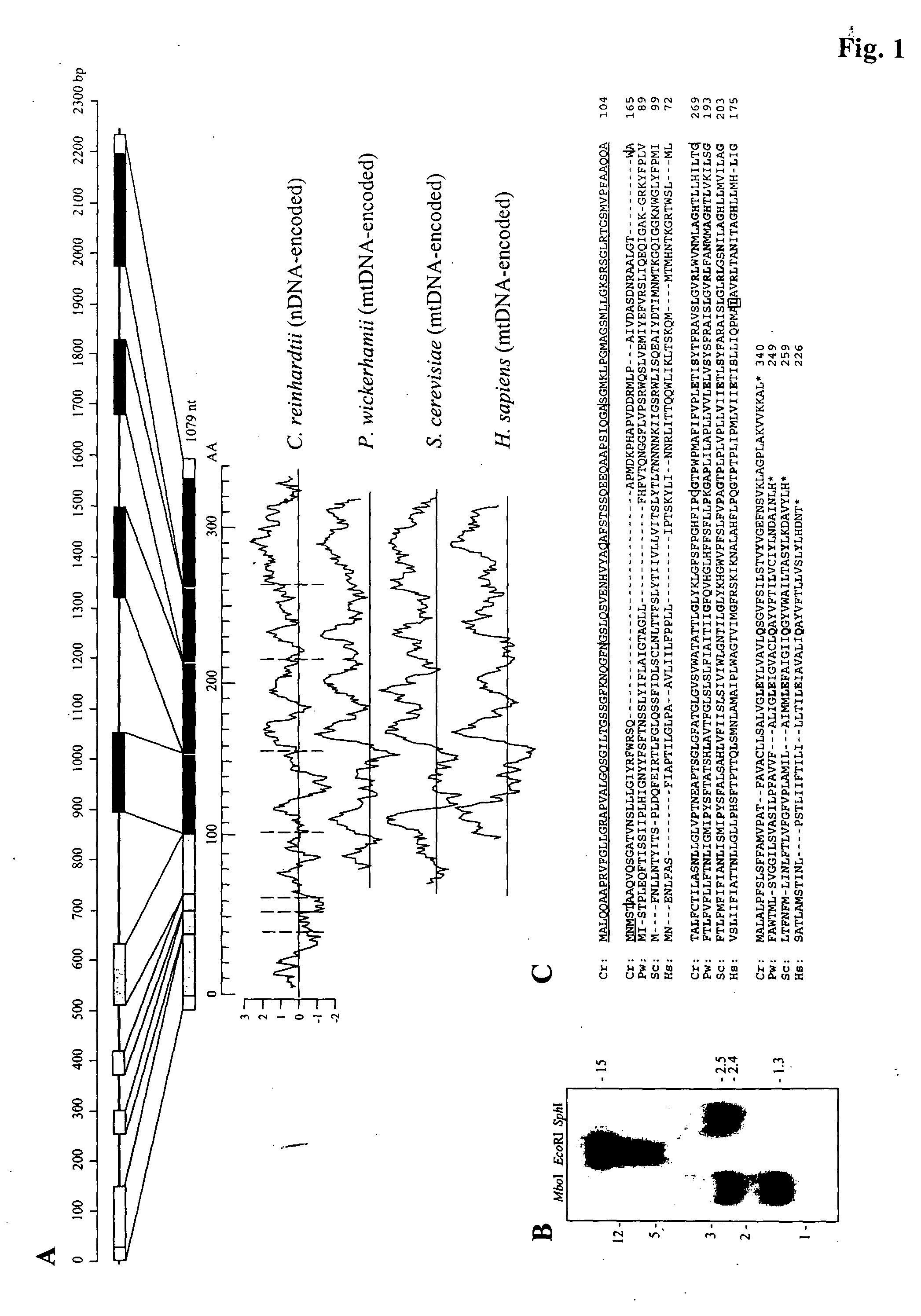Methods for xenotopic expression of nucleus-encoded plant and protist peptides and uses thereof
a technology of nucleus-encoded plant and protist peptide, which is applied in the direction of peptide/protein ingredients, genetic material ingredients, viruses/bacteriophages, etc., can solve the problems of no treatment available for narp, mils, or any other mitochondrial disorder, many of which are lethal
- Summary
- Abstract
- Description
- Claims
- Application Information
AI Technical Summary
Benefits of technology
Problems solved by technology
Method used
Image
Examples
example 1
Isolation of C. reinhardtii ATP6
[0078]Chlamydomonas reinhardtii strain 21 gr (mt+) (CC-1690) was obtained from the Chlamydomonas Genetic Center, Duke University, and was cultured under continuous light at room temperature (Snell, J. Cell Biol., 68:48-69, 1976). Using the Chlamydomonas EST Database (http: / / www.kazusa.orjp / en / plant / chlamy / EST; Asamizu et al., DNA Res., 6:369-73, 1999; Asamizu et al., DNA Res., 7:305-07, 2000), the inventors identified a number of overlapping ESTs encoding the putative ATP6 mRNA. Sets of oligonucleotides were designed on the basis of predicted overlapping ESTs, in order to amplify both the full-length cDNA and the chromosomal gene. Total RNA was extracted using standard methods (Wegener and Beck, Plant Mol. Biol., 16:937-46, 1991). First-strand cDNA was obtained using the SuperScript First Strand Synthesis System for RT-PCR (Gibco BRL, Gaithersburg, Md.). The SMART™ RACE cDNA Amplification Kit (Clontech, Palo Alto, Calif.) was used for determination o...
example 2
Southern-Blot Hybridization
[0079] Ten μg of total genomic DNA was digested with appropriate restriction enzymes, separated through a 1% agarose gel, transferred onto nylon membranes (Schleicher & Schuell BioScience, Inc., Keene, N.H.), and probed with a random-primer-labeled PCR fragment—labeled with a Rapid Prime labeling kit (Roche Molecular Biochemicals)—corresponding to the CrATP6 coding region. Incubation of the probe with the membrane was carried out as previously described (Pan and Snell, J. Biol. Chem., 275:24106-114, 2000).
example 3
Expression of CrATP6
[0080] Because no antibody to CrATP6 is known to be available, the inventors appended an in-frame sequence encoding a FLAG epitope tag (DYKDDDDK) (SEQ ID NO:5) to the 3′ end of the coding region of the full-length CrATP6 cDNA, and inserted the construct into the BamHI and EcoRI sites of the mammalian expression vector pCDNA3 (Invitrogen) using BamHI and EcoRI linkers flanking the insert. Positive clones were confirmed by sequencing. A positive plasmid (plasmid pcDNA3 / 5a-a, referred to herein as “pCrA6F” for clarity and brevity) was isolated using the Qiagen plasmid midi kit (Qiagen, Valencia, Calif.).
[0081] Transient transfections of human HEK 293T and monkey COS7 kidney cells were carried out with FuGENE 6 (Roche Molecular Biochemicals), a non-liposomal transfection reagent, according to the manufacturer's recommendations. Briefly, the DNA-FuGENE 6 complex was made fresh, at a ratio of 3 μl FuGENE to 1 μg plasmid DNA, in serum-free DMEM medium, overlain onto p...
PUM
| Property | Measurement | Unit |
|---|---|---|
| Acidity | aaaaa | aaaaa |
| Nucleic acid sequence | aaaaa | aaaaa |
| Strain point | aaaaa | aaaaa |
Abstract
Description
Claims
Application Information
 Login to View More
Login to View More - R&D
- Intellectual Property
- Life Sciences
- Materials
- Tech Scout
- Unparalleled Data Quality
- Higher Quality Content
- 60% Fewer Hallucinations
Browse by: Latest US Patents, China's latest patents, Technical Efficacy Thesaurus, Application Domain, Technology Topic, Popular Technical Reports.
© 2025 PatSnap. All rights reserved.Legal|Privacy policy|Modern Slavery Act Transparency Statement|Sitemap|About US| Contact US: help@patsnap.com



